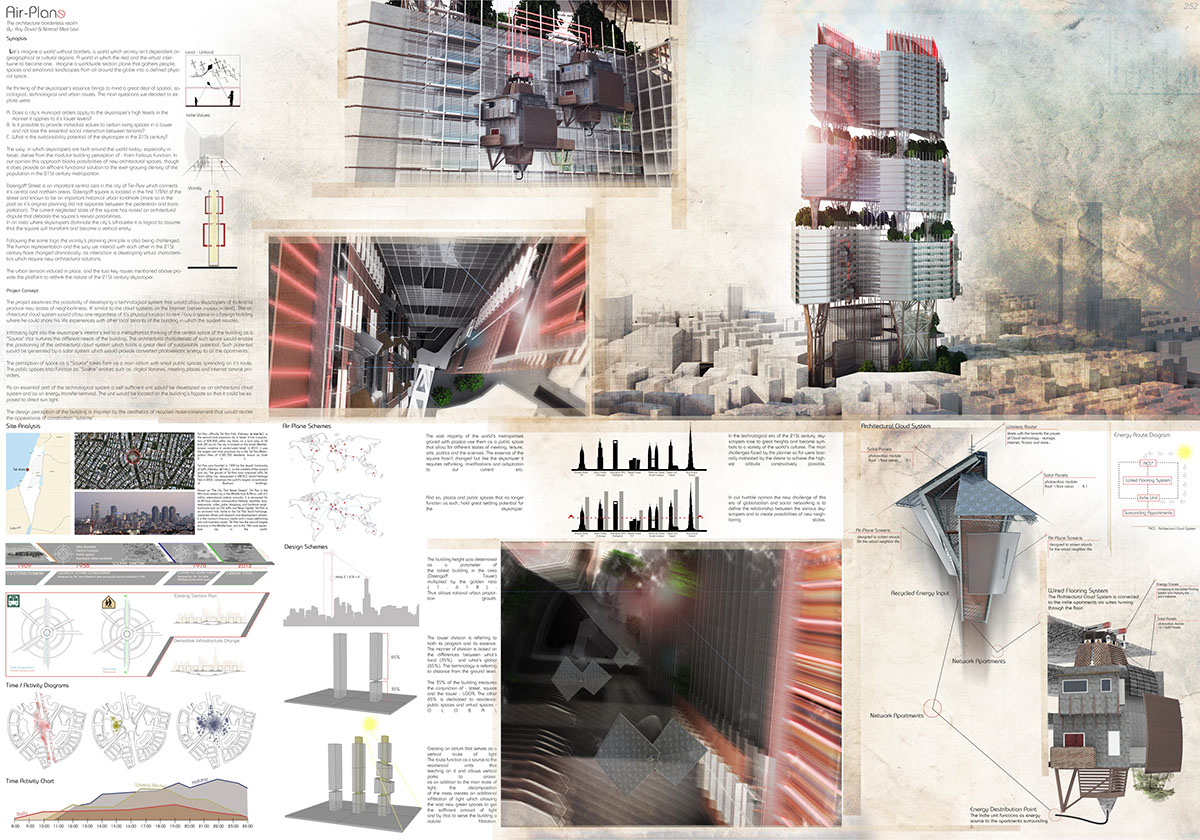
Synopsis
Let’s imagine a world without borders, a world which vicinity isn’tdependent on geographical or cultural regions. A world in which the real andthe virtual intertwine to become one. Imagine a worldwide section plane that gathers people, spaces andemotional landscapes from all around the globe into a defined physical space. Re thinking of the skyscraper’sessence brings to mind a great deal of spatial, sociological, technological andurban issues. The main questions we decided to explore were:
A. Does a city’s municipal orders apply to the skyscraper’s high levelsin the manner it applies to its lower levels?
B. Is it possible to provide individual values to certain living spacesin a tower and not lose the essential social interaction between tenants?
C. What is the sustainability potential of the skyscraper in the 21Stcentury?
The way in which skyscrapers are built around the world today andespecially in Israel derives from the modular building perception of - FormFollows Function. In our opinion this approach blocks possibilities of newarchitectural spaces, though it does provide an efficient functional solutionto the ever-growing density of the population in the 21St centurymetropolitan.
Dizengoff Street is an important central axis in the city of Tel-Avivwhich connects it’s central and northern areas. Dizengoff square is located inthe first 1/3Rd of the street and known to be an important historical urbanlandmark (more so in the past as it’s original planning did not separatebetween the pedestrian and transportation). The current neglected state of thesquare has raised an architectural dispute that debates the square’s revivalpossibilities. In an area where skyscrapers dominate the city’s silhouette itis logical to assume that the square will transform and become a verticalentity.
Following the same logic the vicinity’s planning principle is also beingchallenged. The human representation and the way we interact with each other inthe 21St century have changed dramatically, as interaction is developingvirtual characteristics which require new architectural solutions.
The urban tension induced in place, and the two key issues mentioned aboveprovide the platform to rethink the nature of the 21St century skyscraper.
Project Concept
The projectexamines the possibility of developing a technological system that would allowskyscrapers of its kind to produce new states of neighborliness, IE similar tothe cloud systems on the Internet (server->www->client). Thearchitectural cloud system would allow one regardless of its physical locationto rent / buy a space in a foreign building where he could share his lifeexperiences with other local tenants of the building in which the systemresides.
Infiltrating light into the skyscraper’s interior’s led to ametaphorical thinking of the central space of the building as a"Source" that nurtures the different needs of the building. Thearchitectural characteristic of such space would enable the positioning of thearchitectural cloud system which holds a great deal of sustainable potential.Such potential would be generated by a solar system which would provideconverted photoelectric energy to all the apartments.
The perception of space as a "Source" takes form as a mainatrium with small public spaces spreading on its route. Light further serves assource for: digital libraries, meeting places and Internet service providers. As an essential part of the technologicalsystem a self-sufficient unit would be developed as an architectural cloudsystem and as an energy transfer terminal. The unit would be located on thebuilding’s façade so that it could be exposed to direct sun light.
The design perception of the building is inspired by the aesthetics ofrecycled materials\element that would render theappearance of construction ‘’sublime’’.
Let’s imagine a world without borders, a world which vicinity isn’tdependent on geographical or cultural regions. A world in which the real andthe virtual intertwine to become one. Imagine a worldwide section plane that gathers people, spaces andemotional landscapes from all around the globe into a defined physical space. Re thinking of the skyscraper’sessence brings to mind a great deal of spatial, sociological, technological andurban issues. The main questions we decided to explore were:
A. Does a city’s municipal orders apply to the skyscraper’s high levelsin the manner it applies to its lower levels?
B. Is it possible to provide individual values to certain living spacesin a tower and not lose the essential social interaction between tenants?
C. What is the sustainability potential of the skyscraper in the 21Stcentury?
The way in which skyscrapers are built around the world today andespecially in Israel derives from the modular building perception of - FormFollows Function. In our opinion this approach blocks possibilities of newarchitectural spaces, though it does provide an efficient functional solutionto the ever-growing density of the population in the 21St centurymetropolitan.
Dizengoff Street is an important central axis in the city of Tel-Avivwhich connects it’s central and northern areas. Dizengoff square is located inthe first 1/3Rd of the street and known to be an important historical urbanlandmark (more so in the past as it’s original planning did not separatebetween the pedestrian and transportation). The current neglected state of thesquare has raised an architectural dispute that debates the square’s revivalpossibilities. In an area where skyscrapers dominate the city’s silhouette itis logical to assume that the square will transform and become a verticalentity.
Following the same logic the vicinity’s planning principle is also beingchallenged. The human representation and the way we interact with each other inthe 21St century have changed dramatically, as interaction is developingvirtual characteristics which require new architectural solutions.
The urban tension induced in place, and the two key issues mentioned aboveprovide the platform to rethink the nature of the 21St century skyscraper.
Project Concept
The projectexamines the possibility of developing a technological system that would allowskyscrapers of its kind to produce new states of neighborliness, IE similar tothe cloud systems on the Internet (server->www->client). Thearchitectural cloud system would allow one regardless of its physical locationto rent / buy a space in a foreign building where he could share his lifeexperiences with other local tenants of the building in which the systemresides.
Infiltrating light into the skyscraper’s interior’s led to ametaphorical thinking of the central space of the building as a"Source" that nurtures the different needs of the building. Thearchitectural characteristic of such space would enable the positioning of thearchitectural cloud system which holds a great deal of sustainable potential.Such potential would be generated by a solar system which would provideconverted photoelectric energy to all the apartments.
The perception of space as a "Source" takes form as a mainatrium with small public spaces spreading on its route. Light further serves assource for: digital libraries, meeting places and Internet service providers. As an essential part of the technologicalsystem a self-sufficient unit would be developed as an architectural cloudsystem and as an energy transfer terminal. The unit would be located on thebuilding’s façade so that it could be exposed to direct sun light.
The design perception of the building is inspired by the aesthetics ofrecycled materials\element that would render theappearance of construction ‘’sublime’’.




